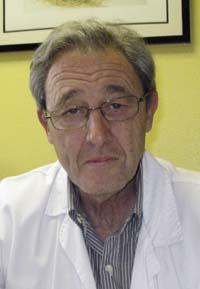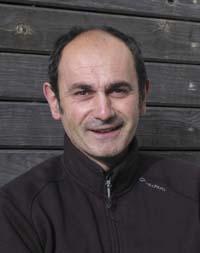Pain

"Imagine a person in a moment of great euphoria. Suddenly he gets a terrible blow. At that time, however, the flow of endorphins is so wild that it does not suffer pain. Endorphins protect from pain." The anesthesiologist Miguel Mar n has set the example above. Dr. Mar n is the head of the Pain Treatment Unit at Donostia Hospital and, in her opinion, serves as an example to show the complexity of the pain mechanism.
There are several ways to define pain, but health experts accept the definition of the International Organization for Pain Research: an unpleasant sensory and emotional experience related to an organism damage, potential, real or imaginary.
As it is a sensation, explains Mar n that is transmitted through the nervous system, "like the rest of sensations". Painful stimuli excite specific pain receptors, noizeptors. From them the impulses go to the spinal cord and then reach the brain. "Then we are aware of the pain," says Marin.
The pain mechanism does not end there. Mar n summarizes what happens in the brain: "Emotional factors are mixed in the brain. In fact, the mechanism also involves the stem and other areas of the brain related to our experiences. And then the question becomes even more complicated, because there are descending systems in which many neurotransmitters intervene. They modulate the feeling. Therefore, as in the example mentioned at the beginning, you may not feel pain despite suffering a heavy blow."
This complexity makes scientists not yet fully aware of the mechanism. However, Mar recognizes that pain is "essential". "We need to avoid attacks, to raise awareness of injuries, to develop prudent behaviors... It is a protective mechanism. Keep in mind that if we didn't feel pain, we would put our hand in a hot pan and nothing warns us that we have to take it away."

There are people who do not perceive pain. They are very rare cases and have genetic origin, that is, they have a mutation in some gene associated with some essential structure in the transmission of pain. These people tend to be injured, traumatized and injured, some do not suffer thirst or temperature changes. Therefore, they have a small life expectancy.
"From this point of view, pain has biological value," said Mar n. "It also serves to perform medical diagnoses. The place of the pain, the intensity of the patient, its location in a certain place or its extension in a diffuse area, the frequency of punctures or the frequency, the duration time, etc., are for us important clues for its detection".
When pain becomes a disease
In these cases, pain may be considered symptom. "Acute pains that disappear once the cause has been resolved. Chronic pain is very different. Precisely when a lot is stretched, that is, when it is chronic, pain becomes a disease. Then, pain loses its biological value, is not valid, not necessary, but reverse."
There are many factors of chronic pain, some very frequent and others less frequent: osteoarthritis, rheumatoid arthritis, neck and back pain (cervical and lumbar), terminal cancer, headache and migraine, neuropathies, ghost episodes...
According to Miguel Mar, people do not understand these pains as well as acute pains: "People are afraid to take morphine, for example, or try to take the least amount of medicine. In fact, it is widespread that medicines to treat chronic pain are bad or harmful. But no one thinks that the pills they have to take to keep tension or cholesterol as they are bad and are willing to take them all their life, right? So with this, even if it seems the same."

Culture is very influential in this. Mar n highlights the difference between Anglo-Saxon or Scandinavian and Mediterranean countries in morphine consumption: "They consume more than we do. Why? Because they have no culture of suffering. And we do, here it seems to us that if we have suffered we have to despair." Thus, despite the low mortality from pain, many die from pain and even more people who suffer from it.
However, he warned that in recent years the attitude is changing. "It's not about subjecting the entire population to drugs, we have to be very careful. But don't be afraid to take the doctor's orders."
On the other hand, he believes that pain medicines are part of treatment and that "psychological and emotional factors are also very important." In fact, pain is often accompanied by harmful physical and psychosocial alterations such as inability to move, weakening of the immune system, sleep disturbances, loss of appetite, excessive dependency on family and caregivers, inadequate use of health services, incapacitation or inefficiency at work, the tendency to loneliness or depression...
Complementary treatments
Mar n believes that chronic non-malignant pains are the most complicated to treat. He says that in the treatment of cancer pain "much progress has been made" and there are no problems: they usually have a short life expectancy and there is no impediment to give you what you need. "Another thing is what we call chronic non-malignant pain. The most common example is back pain, which is the one that generates the most consultations. It is also very common arthritis, headache... In these cases, psychosocial and emotional factors are mixed, with less clean and less regulated treatment."
According to the case, in addition to pharmacological treatment --morphine, other opioids and analgesics, sedatives, antidepressants...-, the Pain Treatment Unit uses specialized techniques. They are usually applied when pharmacological treatment does not yield good results, but are not replaceable but complementary.

"These techniques allow the medication to be halved and greatly improve the quality of life of patients," explains Mar n. They interrupt or modulate the transmission of pain. For example, radiofrequencies burn nerve endings. "Like when the dentist kills the tooth nerve, more or less," explains Mar n. "Then the joints between the nerves come back, but it is temporary and can be done again."
Other times neurolytic agents are used to destroy nerves, such as in cancer patients. In order to modulate pain, electrodes are also placed, so that the pulses generated by the electrodes modify the conduction of pain. Another way to achieve the same goal is the direct application of morphine to the nerve.
In any case, collaboration between disciplines is fundamental: "Sometimes it is not enough with specialized medicines or treatments and the psychologist has to intervene. Or a social worker. For example, in the case of the lonely old man, perhaps the solution is not to give pain relief medicines, but to help a person perform household chores. On the other hand, this major will have to recognize that he cannot go to Benidorm or move around here, and that he will be better in the area of the house, in the area of passage, with a great tranquility".
Therefore, sometimes the measures are not only medical, but are more psychological or socio-sanitary. "That's what our unity is all about," concludes Mar.
Before death
Apart from physical pain, one of the greatest pains a person can suffer is losing someone who loves him. Clinical psychologist Patxi Izagirre specializes in helping people in these situations. According to the case, specialists from other disciplines can also participate in the diagnosis and treatment and it is not easy to generalize it. But in all cases, pain processing is similar.

Izagirre has explained that the death of someone close to him produces a psychotrauma, that is, a profound change in the mental situation. Izagirre explains that in these cases, as in any other situation, the information first reaches a specific place of the brain, the stem, from where it is transferred to another area, the tonsil. "There the distinction is made. Until then physical pain and psychic pain are the same, both are an information. In Amigdalá, physical and emotional sense is given to information."
Izagirre warns that if the tonsil detects that the pain is excessive, that the person exceeds the threshold of what can bear, a dissociation occurs. "Then a signal is sent to the adrenal glands and some neurotransmitters are launched: cortisol, adrenaline, prolactin, oxytocin... They are natural anesthetics that protect from pain in physical damage, while in psychic pain cause the person to get out of reality. That is, experience and consciousness are divided."
This phase, technically called post-traumatic stress, is, according to Izagirre, a "defense mechanism". In his opinion, at first it is necessary to: "We should not consider it pathological. It is pathological if the person becomes hooked, that is, it becomes chronic. Otherwise, it helps the progressive assimilation of the information we have in the tonsils."
Pain awareness
This assimilation occurs in the hippocampus. "In the hippocampus it is given cognitive sense and enters another phase. For this, it is very useful for the person to feel protected and safe. Thus enters the phase of denial, the person explodes crying or screaming... But it is no longer out of reality; it has become aware of what happened," explained Izagirre. At the same time, it has determined that previously released neurotransmitters are partially absorbed and others such as serotonin and dopamine are released.
In this step, the tonsil has an important function: "The amygdala is the refuge of fear, and collecting the experiences there, it will be easier or more difficult to become aware for the person," said Izagirre. In this sense, if previous experiences have had a good end, the person becomes aware before. The opposite happens if the damage builds up or if the person is uncertain, weak or unstable.

In these cases, Izagirre indicates that the pain is "infected": "The concentration of these neurotransmitters is excessive, they last too long in the body, which produces toxicity." In these cases he has announced the danger of obsession, phobia or somatization of pain.
On the contrary, if what happened in the hippocampus is well processed, it passes to the neoortex where the behavioral meaning is given. "Then the experience is integrated and the person has the opportunity, for example, to remember beautiful moments and to remember smiling at that family member or family member who has died..."
Izagirre comments on the work of researchers Van der Kolk and Ledoux to explain what it is: "According to them, in this phase is inscribed the experience lived in the space of the hippocampus Brocka, one of the spaces related to speech. This opens up new neural pathways that seem to help integration into neurocortex." Pain is healing.





